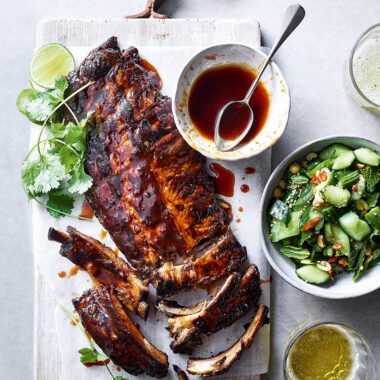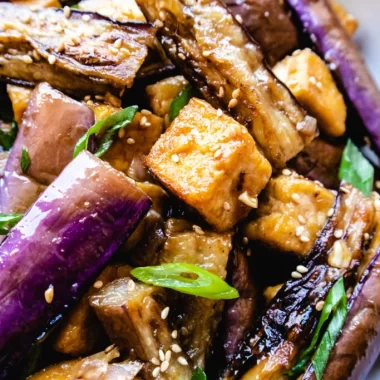Coffee seems to have become a familiar drink to us. However, to process delicious cups of coffee, the “coffee filter” is an indispensable tool. So how to use a Vietnamese coffee filter? The following article of Tasty Touch will help you better understand coffee filters as well as tips for making coffee with a Vietnamese coffee filter!
What is a Vietnamese coffee filter?

The coffee filter is a device used to make coffee, shaped like a cup, the bottom has many lithium holes used to compress and filter coffee, accompanied by a circular compression device placed in the filter, The top has a lid to keep the heat.
Vietnamese filtered coffee is finely ground coffee, put in a filter and brewed with hot water for a few minutes, then filtered out the drips of filter coffee. We often hear familiar names such as: hot black coffee, iced black coffee, and hot milk coffee… These are common forms of filter coffee, depending on the preferences that diners can choose to drink coffee. Pure filter because of its aromatic bitter taste, can also add a little milk to make the cup of coffee become sweeter and fatter.
Vietnamese coffee filters come in different sizes. Depending on your needs, you can choose a large or small coffee filter. Normally, a coffee filter has a diameter of 7-10 cm, fits into a coffee cup, and includes 3 parts: filter cup, filter disc for compression, and filter lid.
Vietnamese coffee filters usually have a height of 7 – 10 cm, with a height of 12 – 15 cm. Depending on the amount of coffee to be brewed, you can choose the appropriate size.
Origin of the Vietnamese coffee filter
The coffee filter appeared in Vietnam in the nineteenth century, at the same time the coffee tree was introduced to Vietnam by the French. The filter has evolved from basic equipment for coffee extraction over the course of time into a significant cultural icon in the tradition of drinking coffee in Vietnam. The image of a coffee cup with a filter placed on it not only travels around the S-shaped country but also follows Vietnamese people to many countries around the world.
Regarding the birth of the coffee filter, there is a theory that: the oldest coffee filter was born in the 70s of the 17th century, in South India. This filter is called Madras Coffee Filter. The original Madras Coffee Filter was made up of two parts, and those parts were: a paper filter and a metal frame.
- The press plate is located in the upper portion of the container, and the water and coffee powder is placed in the lower portion.
- The coffee that has been brewed is stored in the lower container.
The two parts fit together to create a shape like a long cup, the shape is somewhat different from the current Phin cafe which has relatively separate parts as we usually use.
What is a good coffee filter?
Throughout Vietnamese coffee culture’s history, the image of a filter coffee cup has been associated. Additionally, filter coffee has given the Vietnamese people their own identity, brand name, and distinctive quality.
Phin coffee is no stranger to any of us because coffee has become a drink associated with Vietnamese culture for generations. No one knows when the coffee filter appeared, where did the filter coffee come from, who made the coffee filter… Just know that the coffee filter seems to have gone deep into the subconscious of the Vietnamese people, bringing with it both Vietnamese identity and soul.
Many people still wonder how much a good coffee filter is, what kind of coffee filter is good, the price of a coffee filter, and where to buy a coffee filter, considering the following standards. To make a delicious and rich cup of coffee, you need to have a good coffee filter.
A good coffee filter meets the following criteria:
- The number of holes in the filter and the bottom filter should be equal and evenly distributed.
- The size of the filter holes needs to be compatible with the size of the coffee beans after grinding.
- The filter can extract about 55-60 drops of coffee per minute.
- The lid must be tight to retain heat.
- The hole on the lid is evenly distributed, having a thicker density than the hole on the body, and the filter bottom allows the water to penetrate the coffee better.
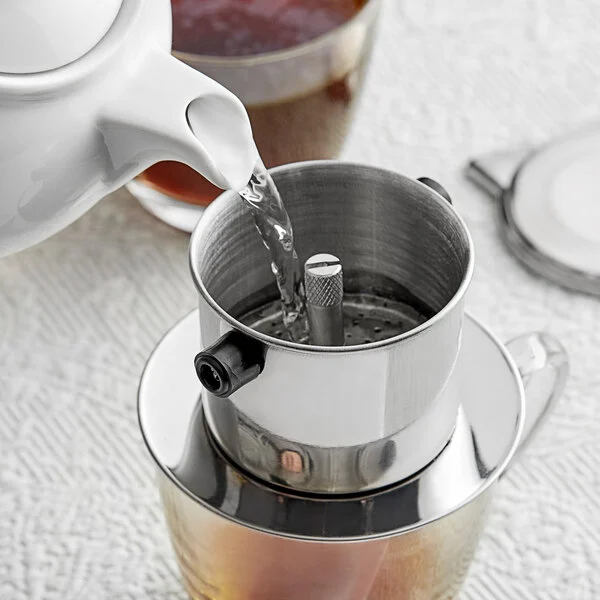
Types of Vietnamese coffee filters
Currently, on the market, there are many types of filters made from many different materials such as: paper coffee filters, aluminum coffee filters, ceramic coffee filters, glass coffee filters, electric coffee filters, bralette coffee filters, etc. Each type of coffee filter has its own pros and cons, let’s find out!
Stainless steel coffee filter
- Stainless steel material.
- Easy to use and clean, with no rust.
- Poor heat retention ability to easily lose water heat.
- No harm to health.
- Disadvantages of stainless steel filter
Professional baristas or coffee connoisseurs will find that the stainless steel filter does not give the full flavor of the coffee due to the large and sparse holes. Moreover, the price of stainless steel filters is usually quite high. Therefore, when choosing a stainless steel filter line, you should have careful consideration.
Aluminum coffee filter
- Eye-catching silver-white aluminum material
- Useful and simple to clean.
- Zero rust
- Excellent heat retention; perfect for coffee brewing.
- Good for health.
Ceramic coffee filter
- Different hues and textures of ceramic.
- Useful and simple to clean.
- Zero rust
- Excellent heat retention; perfect for coffee brewing.
- Good for health.
Because the material is terracotta, it is difficult for the product to create small round holes, so the coffee taste is not standard. This disadvantage is a big minus point that makes coffee connoisseurs not choose this type of coffee filter In addition, the high price compared to other coffee filter materials also makes ceramics increasingly a luxury product, There are very few on the market.
Paper filter
- Convenient, a nice cup of coffee made properly just takes one minute.
- The natural coffee taste should remain
- May be used whenever and anywhere without having to clean the preparation equipment and filters.
- Good for health.
Born in 1990, the filter paper filter is a utility product invented by the Japanese, filter paper helps to limit the harmful effects of coffee powder when brewed directly with the filter. At the same time, this way slows down the flow of coffee, so the flavor is more concentrated.
How to use a Vietnamese coffee filter?
How to Use a Vietnamese Coffee Filter? [5-Step Guideline]
Cuisine: Vietnamese4
servings30
minutes40
minutes300
kcalUsing Vietnamese coffee filter is an art, the barista is an artist because so many factors need to be converged if they want to have a great cup of coffee. To know how to use a Vietnamese coffee filter properly, you have to take the following steps:
Ingredients
Pure coffee: is supplied by the roaster and grinder. If you have a coffee grinder, you can decide to buy coffee beans.
Coffee filter: There are many different types of filters made from ceramic, plastic, aluminum, stainless steel, etc. The aluminum filter is considered the most used tool and gives the best cup of coffee.
Coffee cup: It is best to choose a glass cup.
Boiling water: You should use boiled filtered water, the water temperature is about 93-95 degrees Celsius.
Directions
- Step 1 – Prepare equipment
You need to prepare the equipment such as coffee filters, and glasses, then let them drain and rinse them with hot water.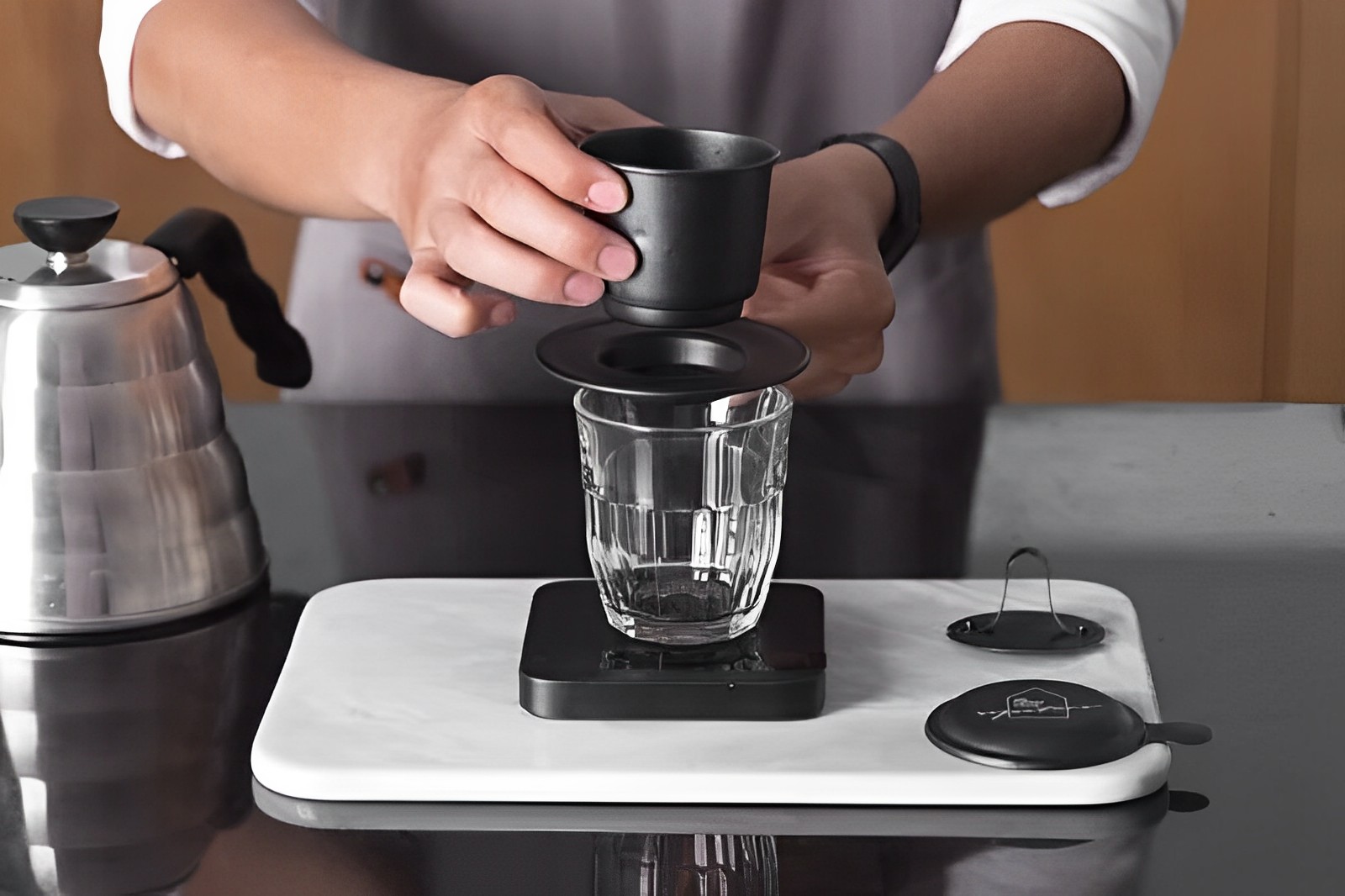
- Step 2 – Put the coffee in the filter
You put the coffee into the filter with a ratio of 6/10 filter, release it lightly and take it out and gently press it. If the impression is too strong, the coffee will have a hard time sleeping and the taste will be burnt when the water mode overflows. On the contrary, if pressed too lightly, the water will quickly turn down to non-dense coffee.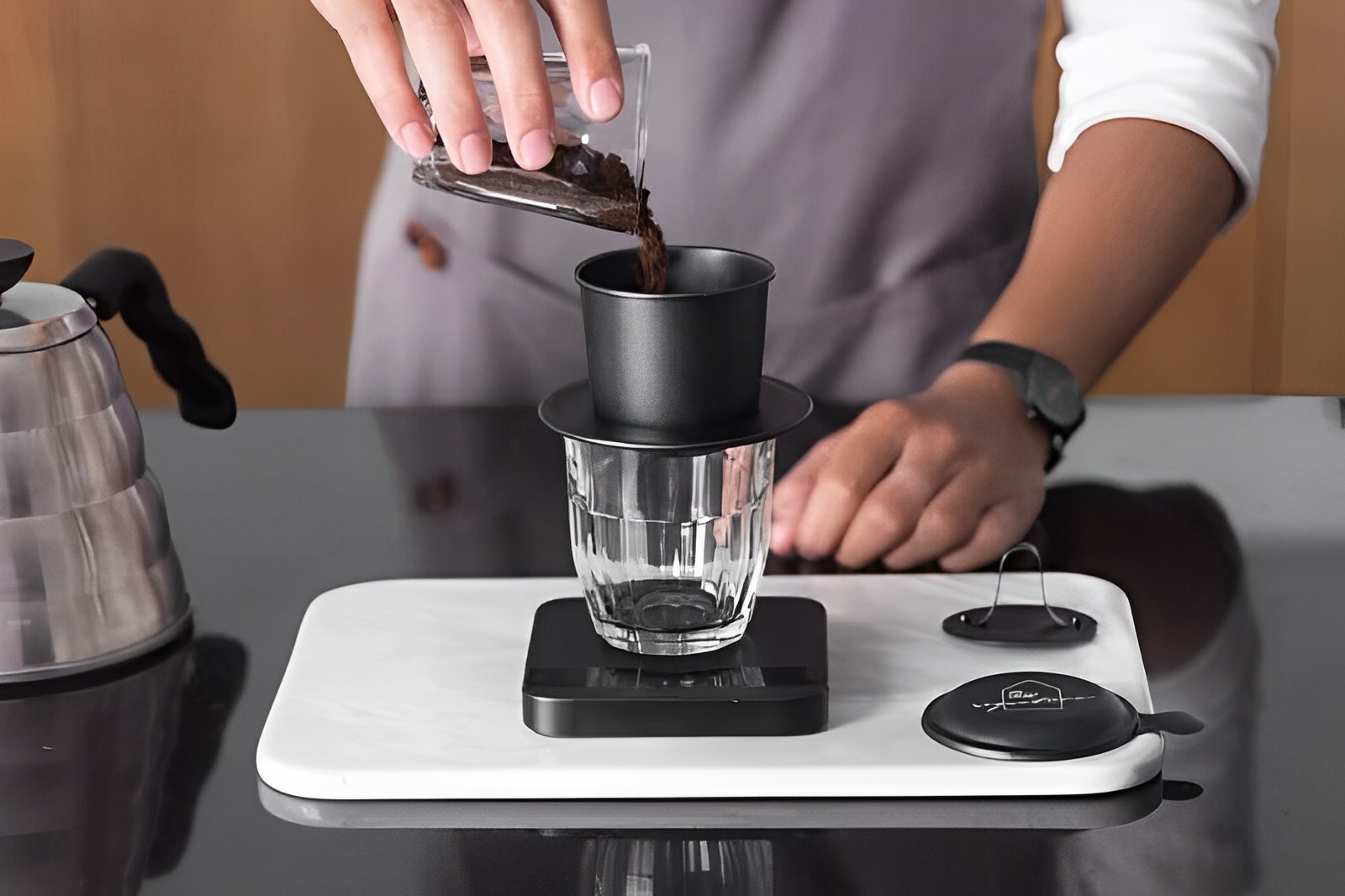
- Step 3 – Prepare to brew
Put the coffee powder into the filter that has been rinsed with hot water. Compress the coffee powder in the filter with a moderate force, not too tight, not too loose.
- Step 4 – Processing
Let the coffee bloom (bloom) in hot water for about 1 minute. Continue to add hot water to the filter and close the lid.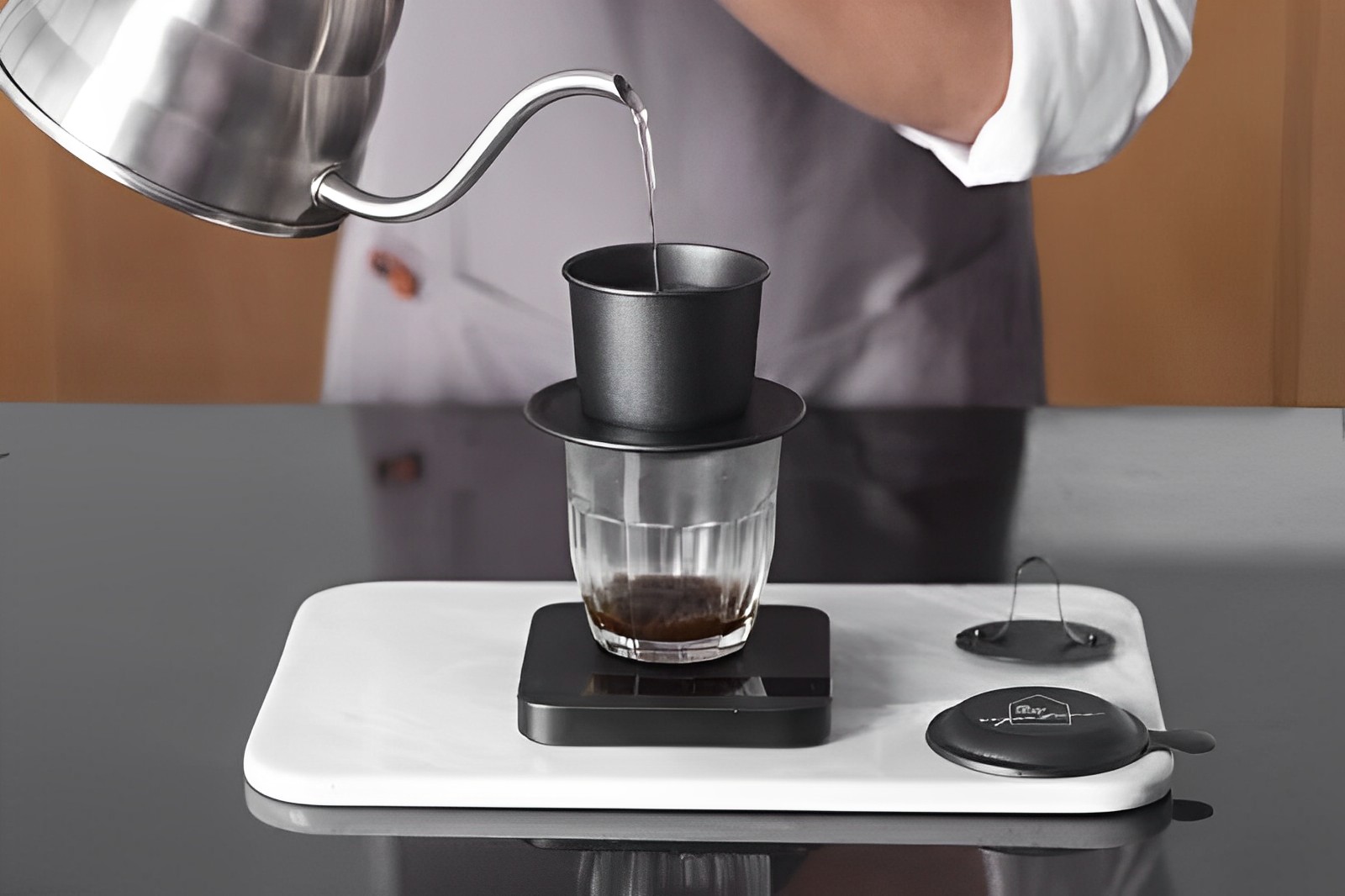
- Step 5 – Finish
The last step is to add sugar, milk, and ice to the coffee. The appropriate amount of milk is 3/10 for a delicious milk coffee.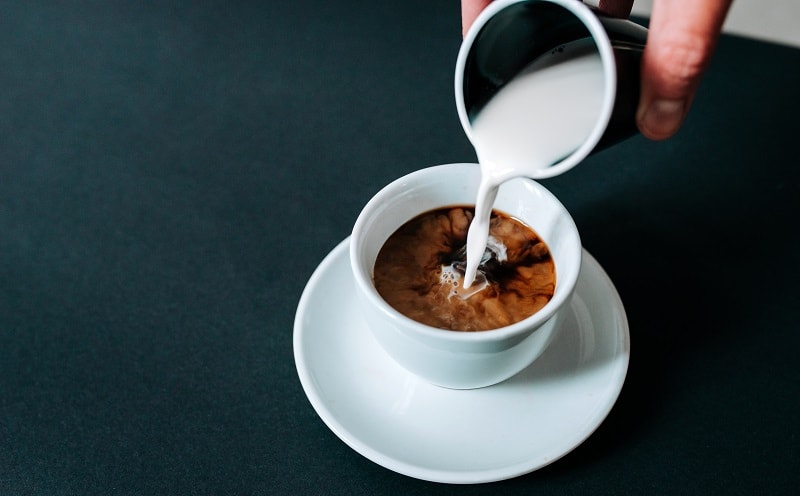
Recipe Video
Tips for making coffee with a Vietnamese coffee filter
Choose pure delicious coffee
The use of high-quality coffee is the single most important factor in producing a delicious cup of filter coffee. If you open a business, you should choose many different types of coffee, and know how to mix them according to the customer’s taste.
If you make coffee for yourself and want to have the most delicious products, the source of the ingredients is even more important. You should use pure coffee instead of coffee with cornstarch and flavoring.
Rinse the filter before brewing
Many people often say that the best way to filter coffee is not while adding water, but before making it. When you preheat the filter and beaker, there will be no difference in the temperature between the inside and outside.
Squeeze coffee with moderate force
Coffee pressure is crucial because it affects the product’s strength. At the same time, if you want to get all the essence of coffee, the water must permeate the entire surface. If you press too tightly, the water will be difficult to pass through, if you press too lightly, the coffee powder has not yet bloomed and has run out of water.
Compress coffee before brewing
The coffee needs to be compressed enough so that the water stays longer in the coffee filter.
In addition to the above notes, you need to time it properly. This is obtained through repeated brewing experience. You will know when it is appropriate to put water in the filter head. Usually, the brewing time is about 5-7 minutes.
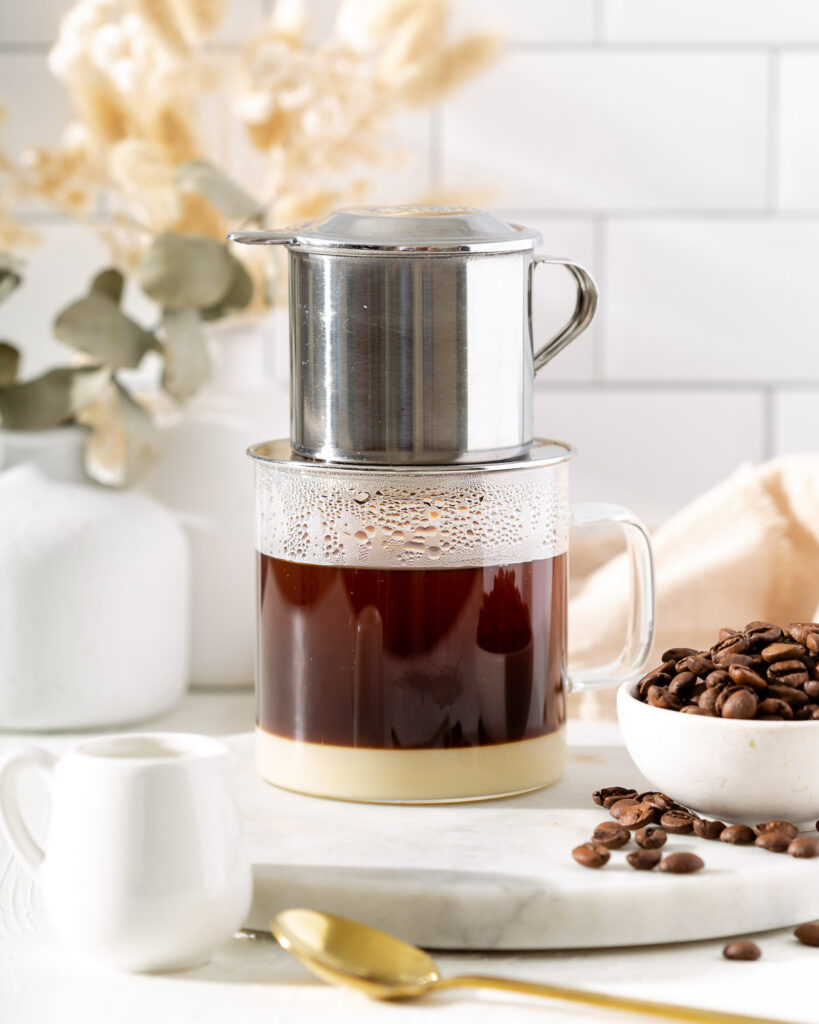
The ratio of water to coffee
Because of the many contaminants and chlorine smell in the water, avoid using tap water to prepare coffee. To get the greatest flavor out of your coffee, use filtered or spring water.
Coffee and water are typically mixed in a ratio of 1:4 or 1:5. 80-100 ml of water, for instance, are needed to brew 25g of coffee. We typically have trouble finding measuring devices for coffee and water at home. 3 tablespoons of coffee powder should be added.
Coffee brewing time
It’s important to complete brewing the coffee within 5-7 minutes after beginning the water pour in order to have an excellent cup of iced milk coffee. The coffee will be sour if the flow of coffee is too rapid (short brewing time) (under extraction). A sluggish water flow will result in bitter coffee (over-extraction).
Coffee typically drips at a rate of roughly one drop per second. This pace is a little bit quicker for pure coffee or coffee that is a little coarsely ground.
How to preserve Vietnamese coffee after brewing?
There should be a way to store coffee after brewing properly to keep the coffee taste.
Following brewing, coffee may be kept in the following ways:
- Pour the coffee into a glass cup after allowing it to cool. Place in the fridge with a cover. Coffee can be kept fresh using this technique for about a day. However, the coffee will lose flavor more quickly the longer you wait. Less than two hours is the optimum use period.
- A thermos can be used to temporarily store coffee as well. However, because it is not frequently used, the coffee may solidify. Keeping coffee hot for too long will also cause it to lose flavor and become more acidic.
Vietnamese coffee filters are increasingly diversified with many different designs and functions. Hopefully, the article has provided you with useful information about how to use a Vietnamese coffee filter properly. Have a nice day!

![How to Use a Vietnamese Coffee Filter? [5-Step Guideline]](https://tastytouch.net/wp-content/uploads/2022/12/theme-1-5-800x530.jpg)
